|
|
|
Sort Order |
|
|
|
Items / Page
|
|
|
|
|
|
|
| Srl | Item |
| 1 |
ID:
101696
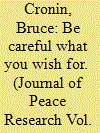

|
|
|
|
|
| Publication |
2010.
|
| Summary/Abstract |
Most theories that seek to explain the relationship between major war and the creation of new political orders posit a direct link between the interests of the winning states and the type of order that emerges. We tend to assume that since most wars are fought for specific purposes and a defined goal, the aftermath of the conflict will reflect the interests and preferences of the winning parties. This article challenges this approach, arguing that the necessity of securing public support and winning allies forces states to make public commitments for a postwar reconstruction that they might otherwise avoid. During the course of the war, states unintentionally limit their options for the postwar reconstruction by publicly articulating a set of 'war aims' that are designed to rally public support and win over potential allies. Since war aims are as much statements of propaganda as of policy they often do not reflect the state interest per se. However, once articulated, they become the official policy of the coalition, and political leaders are forced to implement their principles as the foundation for the new order.
|
|
|
|
|
|
|
|
|
|
|
|
|
|
|
|
| 2 |
ID:
101689


|
|
|
|
|
| Publication |
2010.
|
| Summary/Abstract |
In 2002, the USA asked all countries to sign agreements exempting US citizens from prosecution by the International Criminal Court (ICC) and threatened economic sanctions if they refused. Some countries yielded to this pressure even after ratifying the ICC Statute, while others chose to honor their original commitments. Why were some countries more responsive to US influence than others? This article provides an explanation of state vulnerability to attempts of influence through the lens of economic sanctions. Assessing the success of sanctions is difficult because of the selection bias in the instances of the use of such strategies observed by the researcher. Since all countries were asked to sign such agreements, one can observe exactly which signed, whether sanctions were enforced, and how quickly countries responded to such pressure. Arguments about sources of influence - shared interests, economic and security dependence, and domestic politics - are tested using an original dataset collected on country decisions to sign bilateral immunity agreements (BIAs). The authors find support for some existing explanations, including relative power and the relationship of dependency, while previously held beliefs about alliance and security relationships appear to be less influential on decisions to ratify BIAs. These findings have implications for existing research programs on economic sanctions, international organizations, and power politics.
|
|
|
|
|
|
|
|
|
|
|
|
|
|
|
|
| 3 |
ID:
101686


|
|
|
|
|
| Publication |
2010.
|
| Summary/Abstract |
This article studies the effects of conflict onset on asset markets applying the event study methodology. The authors consider a sample of 101 internal and inter-state conflicts during the period 1974-2004 and find that a sizeable fraction of them has had a significant impact on stock market indices, exchange rates, oil and commodity prices. This fraction is inconsistent with pure chance, that is, with the selected probability of type-I errors in our tests of statistical significance. The results suggest that, on average, national stock markets are more likely to display positive than negative reactions to conflict onset. When the authors distinguish between internal and inter-state conflicts, they find that the fraction of significant results is higher for international conflicts. When the authors classify events according to the region where they occur, they find that Asia and the Middle East are the regions where conflicts tend to have the strongest effects. Finally, the article reports evidence that abnormal returns would have accrued to investors systematically exploiting conflict onset to implement conflict-driven strategies. Results are robust to selecting a subset of high-intensity conflicts and to expanding the time window over which conflict events are defined. The findings of the article confirm the economic importance of the effects of conflicts on asset markets.
|
|
|
|
|
|
|
|
|
|
|
|
|
|
|
|
| 4 |
ID:
101692
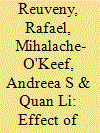

|
|
|
|
|
| Summary/Abstract |
Does warfare affect the environment? This question has received some theoretical and empirical attention, but none of the extant studies has employed large-N statistical models. This article theorizes the possible effects of warfare on the environment and estimates large-N statistical models of these effects on CO2 emissions per capita, NOX emissions per capita, the rate of change in forested area, and a composite indicator of environmental stress reduction. The results indicate that warfare significantly affects the environment, but the signs and sizes of these effects depend on the environmental attribute (whether the fighting is at home or abroad) and development (whether the fighting country is developed or less developed). Warfare reduces CO2 emissions, but the effect is weaker in less developed countries (LDCs) than in developed countries (DCs). Warfare increases deforestation when fought at home and promotes forest growth when fought abroad, particularly in the LDCs. Warfare at home reduces NOX emissions for the LDCs and increases them for the DCs; warfare abroad increases NOX emissions for both the DCs and LDCs. Finally, warfare increases aggregated environmental stress, particularly for the LDCs when fought at home and for the DCs when fought abroad. The sizes of these effects are on par with or larger than the mandated or recommended policy goals stated by the US government for changes in CO 2 and NOX emissions, and by the World Bank (and by implication the DCs driving its policy) for the rate of deforestation, during the coming decade.
|
|
|
|
|
|
|
|
|
|
|
|
|
|
|
|
| 5 |
ID:
101693
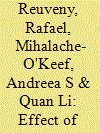

|
|
|
|
|
| Publication |
2010.
|
| Summary/Abstract |
Does warfare affect the environment? This question has received some theoretical and empirical attention, but none of the extant studies has employed large-N statistical models. This article theorizes the possible effects of warfare on the environment and estimates large-N statistical models of these effects on CO2 emissions per capita, NOX emissions per capita, the rate of change in forested area, and a composite indicator of environmental stress reduction. The results indicate that warfare significantly affects the environment, but the signs and sizes of these effects depend on the environmental attribute (whether the fighting is at home or abroad) and development (whether the fighting country is developed or less developed). Warfare reduces CO2 emissions, but the effect is weaker in less developed countries (LDCs) than in developed countries (DCs). Warfare increases deforestation when fought at home and promotes forest growth when fought abroad, particularly in the LDCs. Warfare at home reduces NOX emissions for the LDCs and increases them for the DCs; warfare abroad increases NOX emissions for both the DCs and LDCs. Finally, warfare increases aggregated environmental stress, particularly for the LDCs when fought at home and for the DCs when fought abroad. The sizes of these effects are on par with or larger than the mandated or recommended policy goals stated by the US government for changes in CO 2 and NOX emissions, and by the World Bank (and by implication the DCs driving its policy) for the rate of deforestation, during the coming decade.
|
|
|
|
|
|
|
|
|
|
|
|
|
|
|
|
| 6 |
ID:
101691


|
|
|
|
|
| Publication |
2010.
|
| Summary/Abstract |
We conduct an empirical analysis of the geographic, economic, and social factors that contributed to the spread of civil war in Nepal over the period 1996-2006. This within-country analysis complements existing cross-country studies on the same subject. Using a detailed dataset to track civil war casualties across space and over time, several patterns are documented. Conflict-related deaths are significantly higher in poorer districts and in geographical locations that favor insurgents, such as mountains and forests; a 10 percentage point increase in poverty is associated with 25-27 additional conflict-related deaths. This result is similar to that documented in cross-country studies. In addition, the relationship with poverty and geography is similar for deaths caused by the insurgents and deaths caused by the state. Furthermore, poorer districts are likely to be drawn into the insurgency earlier, consistent with the theory that a lower cost of recruiting rebels is an important factor in starting conflict. On the other hand, geographic factors are not significantly associated with such onset, suggesting that they instead contribute to the intensity of violence only after conflict has started. Finally, in contrast to some cross-country analyses, ethnic and caste polarization, land inequality, and political participation are not significantly associated with violence.
|
|
|
|
|
|
|
|
|
|
|
|
|
|
|
|
| 7 |
ID:
101688


|
|
|
|
|
| Publication |
2010.
|
| Summary/Abstract |
In this article, it is argued that interstate alliances function as public costly signals of state intentions to cooperate militarily, and as such, they should be expected to influence state expectations within dyads, between dyads, and across time. Accurate statistical modeling of interstate military alliances thus requires that researchers escape the assumption of independent units of observation, which is built into most of the statistical tools currently used by international relations scholars, as such models can be expected to produce unbiased parameter estimates in this domain only if the decisions to create and dissolve interstate alliances are formulated in isolated dyadic bubbles. The use of stochastic actor-oriented models, combined with Markov simulations of network evolution, is shown to be a productive alternative method of modeling interstate alliances, which allows the researcher to avoid the assumption of dyadic independence by incorporating theory-driven assumptions about patterns of extra-dyadic interdependence directly into the functional form of the statistical model. The results demonstrate that triadic patterns of amity and enmity exercise powerful influence over the selection of alliance partners and the evolution of the global alliance network. The results also show that failure to incorporate patterns of extra-dyadic interdependence into our statistical models of interstate alliance decisions is likely to result in biased parameter estimates.
|
|
|
|
|
|
|
|
|
|
|
|
|
|
|
|
| 8 |
ID:
101694


|
|
|
|
|
| Publication |
2010.
|
| Summary/Abstract |
Two studies question whether economic interdependence promotes peace, arguing that previous research has not adequately considered the endogeneity of trade. Using simultaneous equations to capture the reciprocal effects, they report that trade does not reduce conflict, though conflict reduces trade. These results are puzzling on logical grounds. Trade should make conflict less likely, ceteris paribus, if interstate violence adversely affects commerce; otherwise, national leaders are acting irrationally. In re-analyzing the authors' data, this article shows that trade does promote peace once the gravity model is incorporated into the analysis of conflict. Both trade and conflict are influenced by nations' sizes and the distance separating them, so these fundamental exogenous factors must be included in models of conflict as well as trade. One study errs in omitting distance when explaining militarized disputes. The other does not adequately control for the effect of size (or power). When these theoretically informed changes are made, the pacific benefit of trade again appears. In new simultaneous analyses, the article confirms that trade promotes peace and conflict contemporaneously reduces commerce, even with extensive controls for traders' rational expectations of violence. Previous studies that address the endogeneity of trade by controlling for the years of peace - as virtually all have done since 1999 - have not overstated the benefit of interdependence. Commerce promotes peace because violence has substantial costs, whether these are paid prospectively or contemporaneously.
|
|
|
|
|
|
|
|
|
|
|
|
|
|
|
|
| 9 |
ID:
101687
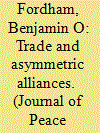

|
|
|
|
|
| Publication |
2010.
|
| Summary/Abstract |
Alliances are usually understood as a way for states to aggregate military capabilities in the face of a common threat. From this perspective, the willingness of relatively powerful states to form alliances with much weaker partners is puzzling. The weaker ally often adds little to the stronger state's security and may increase its chance of military entanglement. This article presents evidence that international trade helps explain these alliances. States that have the power to do so have incentives to protect their trading relationships against interference from either third states or internal conflict. Alliances are one means of providing this protection. This argument differs from most other research on trade and alliances, which reverses the causal arrow and suggests instead that alliances increase trade. Empirical analysis indicates that trade increases the probability of alliance formation in major power-minor power dyads and decreases the chance that alliances will dissolve. These results are robust to a variety of changes in the specification of the model and the data used for estimation. They also do not stem from any influence of alliance relationships on trade. An analysis of the effect of alliance formation on change in the level of bilateral trade turns up no evidence that the formation of an alliance increases commerce.
|
|
|
|
|
|
|
|
|
|
|
|
|
|
|
|
| 10 |
ID:
101697
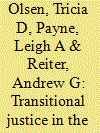

|
|
|
|
|
| Publication |
2010.
|
| Summary/Abstract |
This article presents a new dataset of transitional justice mechanisms utilized worldwide from 1970-2007. These data complement the growing body of quantitative and comparative analyses of transitional justice. This article summarizes three important contributions made by the dataset. First, it includes five transitional justice mechanisms (trials, truth commissions, amnesties, reparations, and lustration policies), allowing scholars to avoid many of the methodological errors committed by performing single-mechanism studies. Second, it provides an expanded sample, both temporally and geographically, to facilitate greater comparative and policy impact. Third, the dataset enables scholars to analyze transitional justice across a variety of political contexts, including democratic transitions and civil wars. These data illuminate a new set of general trends and patterns in the implementation of transitional justice worldwide. The findings show that countries adopt amnesties more often than other mechanisms. They predominantly grant them in the context of civil war and to opponents of the state, rather than state agents. Courts rarely prosecute those currently in power for human rights violations. In civil war settings, rebels, rather than state actors, face trials. In post-authoritarian settings, courts try former authoritarian actors, but do not address crimes committed by the opposition to authoritarian rule. The dataset also reveals regional patterns of mechanism usage. Trials, lustration policies, and reparations occur most often in Europe. Non-European countries more frequently adopt truth commissions and amnesties than do their European counterparts, with a particularly high number of amnesties granted in Latin America.
|
|
|
|
|
|
|
|
|
|
|
|
|
|
|
|
| 11 |
ID:
101690
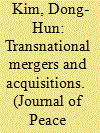

|
|
|
|
|
| Publication |
2010.
|
| Summary/Abstract |
While globalization advocates have argued that market liberalization and economic integration will strengthen human rights by promoting economic development and facilitating the diffusion of rights-supportive norms and values, critics contend that the same processes threaten to undermine human rights through economic exploitation and the repressive actions of pro-growth governments. To contribute to this debate, the authors examine the relationship between one aspect of economic globalization, foreign direct investment, and human rights performance. But the authors go beyond existing studies of the human rights impact of foreign direct investment, which generally lump all forms of FDI into a single aggregate indicator, by focusing on one specific form of FDI, transnational mergers and acquisitions (M&As). This is a particularly important area to explore given the human rights literature's emphasis on multinational corporations as both potential violators of human rights and catalysts for improvements in human rights performance. This study examines the impact of cross-border M&As, which have become an increasingly prominent form of foreign direct investment over the last 25 years, on human rights performance globally from 1981 through 2006. The results of the statistical analysis show that transnational mergers and acquisitions have a positive impact on human rights conditions across several indicators, including physical integrity rights, empowerment rights, workers' rights, and women's economic rights. This positive impact of cross-border M&As is particularly pronounced in developing countries.
|
|
|
|
|
|
|
|
|
|
|
|
|
|
|
|
| 12 |
ID:
101695
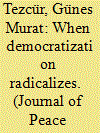

|
|
|
|
|
| Publication |
2010.
|
| Summary/Abstract |
This article addresses a historical puzzle: Why did the insurgent PKK (Partiya Karkerên Kurdistan), which was militarily defeated, which renounced the goal of secession, and whose leader was under the custody of the Turkish state, remobilize its armed forces in a time when opportunities for the peaceful solution of the Kurdish question were unprecedented in Turkey? The PKK's radicalization at a period of EU-induced democratization in Turkey counters the conventional argument that fostering democracy would reduce the problems of ethnic conflict. Explanations based on resource mobilization, political opportunity structures, and cognitive framing fail to provide a satisfactory answer. The article argues that democratization will not necessarily facilitate the end of violent conflict as long as it introduces competition that challenges the political hegemony of the insurgent organization over its ethnic constituency. Under the dynamics of competition, the survival of the organization necessitates radicalization rather than moderation. As long as the insurgent organization successfully recruits new militants, democratization is not a panacea to violent conflict. The findings indicate that research on the micro-level dynamics of insurgency recruitment will contribute to a better understanding of ethnic conflict management. Data come from multiple sources including ethnographic fieldwork, statistical analyses of quantitative data (i.e. spatial clustering and ecological inference), and systematic reading of original documents.
|
|
|
|
|
|
|
|
|
|
|
|
|
|
|
|
|
|
|
|
|